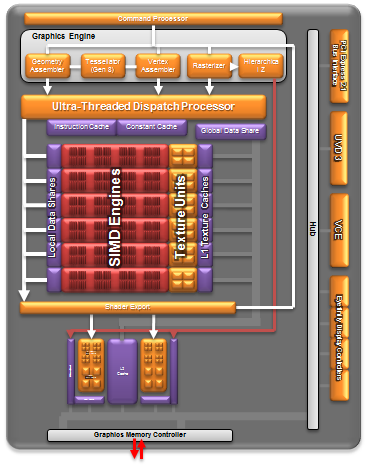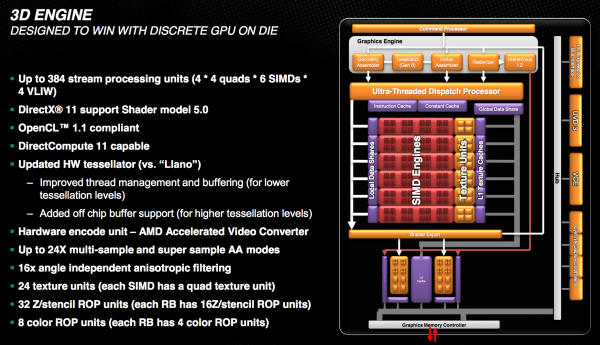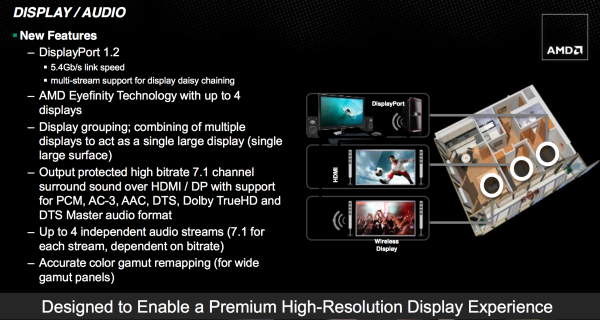The AMD Trinity Review (A10-4600M): A New Hope
by Jarred Walton on May 15, 2012 12:00 AM ESTImproved Turbo
Trinity features a much improved version of AMD's Turbo Core technology compared to Llano. First and foremost, both CPU and GPU turbo are now supported. In Llano only the CPU cores could turbo up if there was additional TDP headroom available, while the GPU cores ran no higher than their max specified frequency. In Trinity, if the CPU cores aren't using all of their allocated TDP but the GPU is under heavy load, it can exceed its typical max frequency to capitalize on the available TDP. The same obviously works in reverse.
Under the hood, the microcontroller that monitors all power consumption within the APU is much more capable. In Llano, the Turbo Core microcontroller looked at activity on the CPU/GPU and performed a static allocation of power based on this data. In Trinity, AMD implemented a physics based thermal calculation model using fast transforms. The model takes power and translates it into a dynamic temperature calculation. Power is still estimated based on workload, which AMD claims has less than a 1% error rate, but the new model gets accurate temperatures from those estimations. The thermal model delivers accuracy at or below 2C, in real time. Having more accurate thermal data allows the turbo microcontroller to respond quicker, which should allow for frequencies to scale up and down more effectively.
At the end of the day this should improve performance, although it's difficult to compare directly to Llano since so much has changed between the two APUs. Just as with Llano, AMD specifies nominal and max turbo frequencies for the Trinity CPU/GPU.
A Beefy Set of Interconnects
The holy grail for AMD (and Intel for that matter) is a single piece of silicon with CPU and GPU style cores that coexist harmoniously, each doing what they do best. We're not quite there yet, but in pursuit of that goal it's important to have tons of bandwidth available on chip.
Trinity still features two 64-bit DDR3 memory controllers with support for up to DDR3-1866 speeds. The controllers add support for 1.25V memory. Notebook bound Trinities (Socket FS1r2 and Socket FP2) support up to 32GB of memory, while the desktop variants (Socket FM2) can handle up to 64GB.
Hyper Transport is gone as an external interconnect, leaving only PCIe for off-chip IO. The Fusion Control Link is a 128-bit (each direction) interface giving off-chip IO devices access to system memory. Trinity also features a 256-bit (in each direction, per memory channel) Radeon Memory Bus (RMB) direct access to the DRAM controllers. The excessive width of this bus likely implies that it's also used for CPU/GPU communication as well.
IOMMU v2 is also supported by Trinity, giving supported discrete GPUs (e.g. Tahiti) access to the CPU's virtual memory. In Llano, you used to take data from disk, copy it to memory, then copy it from the CPU's address space to pinned memory that's accessible by the GPU, then the GPU gets it and brings it into its frame buffer. By having access to the CPU's virtual address space now the data goes from disk, to memory, then directly to the GPU's memory—you skip that intermediate mem to mem copy. Eventually we'll get to the point where there's truly one unified address space, but steps like these are what will get us there.
The Trinity GPU
Trinity's GPU is probably the most well understood part of the chip, seeing as how its basically a cut down Cayman from AMD's Northern Islands family. The VLIW4 design features 6 SIMD engines, each with 16 VLIW4 arrays, for a total of up to 384 cores. The A10 SKUs get 384 cores while the lower end A8 and A6 parts get 256 and 192, respectively. FP64 is supported but at 1/16 the FP32 rate.

As AMD never released any low-end Northern Islands VLIW4 parts, Trinity's GPU is a bit unique. It technically has fewer cores than Llano's GPU, but as we saw with AMD's transition from VLIW5 to VLIW4, the loss didn't really impact performance but rather drove up efficiency. Remember that most of the time that 5th unit in AMD's VLIW5 architectures went unused.
The design features 24 texture units and 8 ROPs, in line with what you'd expect from what's effectively 1/4 of a Cayman/Radeon HD 6970. Clock speeds are obviously lower than a full blown Cayman, but not by a ton. Trinity's GPU runs at a normal maximum of 497MHz and can turbo up as high as 686MHz.
Trinity includes AMD's HD Media Accelerator, which includes accelerated video decode (UVD3) and encode components (VCE). Trinity borrows Graphics Core Next's Video Codec Engine (VCE) and is actually functional in the hardware/software we have here today. Don't get too excited though; the VCE enabled software we have today won't take advantage of the identical hardware in discrete GCN GPUs. AMD tells us this is purely a matter of having the resources to prioritize Trinity first, and that discrete GPU VCE support is coming.















271 Comments
View All Comments
bji - Tuesday, May 15, 2012 - link
What exactly about the review turned you off from Trinity for HTPC purposes?Was it the good-enough-for-HTPC CPU performance?
The superior GPU performance?
The better power efficiency?
The lower power use?
The cooler GPU?
The lower price (than the i3 you mentioned)?
Honestly just curious about why you so summarily concluded that Trinity wouldn't be a good choice from your HTPC when I can't see anything in the article that would allow you to draw that conclusion.
Unless it was the CPU chart comparison against at 3x as expensive CPU that you would never use in an HTPC anyway?
cjs150 - Wednesday, May 16, 2012 - link
The main purpose will be as an HTPC, video transcoding is very important, look back to Jarred's review, Intel are winning by a large margin.For the case I intend to use as long as TDP is under 50W there are no concerns.
For me the i7-3770T will be the way to go. But you may want to try AMD. If I had built the HTPC last year there would have been no question that AMD would have been the right choice - Atom is/was useless. Maybe next year the table will turn again.
Spunjji - Wednesday, May 16, 2012 - link
Soooo... AMD are good against Atom, so you would have bought them then... but now you're buying an i7 with which they (obviously) cannot compete? That particular argument is a little difficult to follow, unless your requirements have drastically altered. :)To be fair to AMD, most people I know don't do transcodes while at the machine so speed isn't terribly relevant past a certain point, but I understand this may be different for you.
DellaMirandola13 - Tuesday, May 15, 2012 - link
I have really been looking forward to this review, nice to see a reasonably competitive CPU-market. Thank you.I am not a (serious) enthusiast, my best suit is lurking, but I was very excited to learn about the heterogeneous aspect. Is it possible you could elaborate or perhaps link to a comprehensive elaboration on the prospects of heterogeneous computing.
As far as I could tell, it seemed very useful in navigating within GIS-applications (particularly when you have to load roads or other kinds of grids on a map), but that's pure speculation.
Jedibeeftrix - Tuesday, May 15, 2012 - link
I would be interested in a 14" hp sleekbook if it comes with the 25w 4655M APU, as the full 384 shaders would be nice, otherwise I will wait till 28nm APU's arrive in 2013 sporting GCN.Ps test trinity with blender cycles.
Veroxious - Tuesday, May 15, 2012 - link
I am rather baffled by the fact that Ivy Bridge did not bring substantial battery life improvements with it 22nm process. Is it as a result of the trigate transistor tech? By extension when AMD moves to 22nm will it also be trigate seeing that they no longer have their own foundry? Has trigate given the purported benefits that were punted when it was announced, or is it simply a case of the 22nm node not being mature enough?JKnows - Tuesday, May 15, 2012 - link
It would be nice to see those game test in High settings! My personal tests shows in high details settings Llano faster than HD4000, Trinity should be much faster.tipoo - Tuesday, May 15, 2012 - link
This is true. The HD4000 falls further and further behind as you increase the detail settings; that's where AMDs implementation shines.JarredWalton - Tuesday, May 15, 2012 - link
Go look at Mobile Bench: the results for our "High 900p" testing is in there.http://www.anandtech.com/bench/Product/600?vs=580
But just to summarize, at 900p "High" settings, Trinity's lead over HD 4000 grows to 26% in our seven "2012 Suite" games. Also worth note is that Trinity is >30 FPS in three titles (DiRT 3, Portal 2, and Total War: Shogun 2) while Ivy Bridge is >30 FPS only in DiRT 3 (but comes very close in Skyrim).
Alexko - Tuesday, May 15, 2012 - link
"I’d say AMD GPUs as well, but I’m still waiting for a better switchable graphics solution."You mean like Enduro?